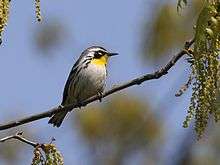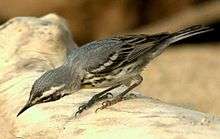Yellow-throated warbler
| Yellow-throated warbler | |
|---|---|
 | |
| Scientific classification | |
| Kingdom: | Animalia |
| Phylum: | Chordata |
| Class: | Aves |
| Order: | Passeriformes |
| Family: | Parulidae |
| Genus: | Setophaga |
| Species: | S. dominica |
| Binomial name | |
| Setophaga dominica (Linnaeus, 1766) | |
 | |
| Range of S. dominica Breeding range Year-round range Wintering range | |
| Synonyms | |
| |
The yellow-throated warbler (Setophaga dominica) is a small migratory songbird species breeding in temperate North America. It belongs to the New World warbler family (Parulidae).[2]
Description

In summer, male yellow-throated warblers display grey upperparts and wings, with double white wing bars. Their throats are yellow, and the remainder of their underparts are white, and are streaked with black on the flanks. Their heads are strongly patterned in black and white, with a long supercilium; the different subspecies may display yellow and white superciliums. Remiges and rectrices are black.[2] They measure 14 cm (5.5 in) long.[3]
Other plumages of these birds – females immatures and non-breeding males – resemble washed-out versions of the summer males; in particular they have a less crisply defined strong head pattern. They also have less bright yellows, and dark grey feathers instead of black ones in the body plumage. Compared to many other New World warblers, sexual dimorphism is slight however.[2]
The males' songs are clear, descending whistles. The calls are high sees or sharp chips.[2]
Ecology

These birds breed in southeastern North America, and their breeding ranges extend from southern Pennsylvania and northern Missouri, to the Gulf of Mexico. One subspecies, from northwest Florida, is resident all year round. The other populations of this species are migratory, wintering at the Gulf Coast, eastern Central America, and the Caribbean. Vagrant wintering birds are sometimes seen in northernmost South America.[2][4]
The yellow-throated warbler is a woodland species with a preference for coniferous or swamp tree species, in which it preferably nests. They are insectivorous, but will include a considerable amount of berries and nectar in their diet outside the breeding season. Food is typically picked off tree branches directly, but flying insects may be caught in a brief hover.[2][5]
These birds build cup-shaped nests which are built in a trees, and are concealed amongst conifer needles or Spanish Moss (Tillandsia usneoides). Their clutches consist of 3–5 (usually 4) eggs.[2]
The yellow-throated warbler is not considered a threatened species by the IUCN.[1]
References
- 1 2 BirdLife International (2013). "Dendroica dominica". IUCN Red List of Threatened Species. Version 2013.2. International Union for Conservation of Nature. Retrieved 26 November 2013.
- 1 2 3 4 5 6 7 Jon Curson; David Quinn & David Beadle (1994). New World Warblers. London: Christopher Helm. ISBN 0-7136-3932-6.
- ↑ Scott, Shirley L., ed. (1994). Field Guide to the Birds of North America (2nd ed.). The National Geographic Society. pp. 366–367. ISBN 0-87044-692-4.
- ↑ Ralf Strewe & Cristobal Navarro (2004). "New and noteworthy records of birds from the Sierra Nevada de Santa Marta region, north-eastern Colombia" (PDF). Bulletin of the British Ornithologists' Club. 124 (1): 38–51.
- ↑ Storrs L. Olson; Helen F. James & Charles A. Meister (1981). "Winter field notes and specimen weights of Cayman Island Birds". Bulletin of the British Ornithologists' Club. 101 (3): 339–346. hdl:10088/6535.
External links
| Wikimedia Commons has media related to Setophaga dominica. |
| Wikispecies has information related to: Setophaga dominica |
- "Yellow-throated warbler media". Internet Bird Collection.
- Yellow-throated warbler photo gallery at VIREO (Drexel University)
- Yellow-throated warbler species account at NeotropicalBirds (Cornell University)
